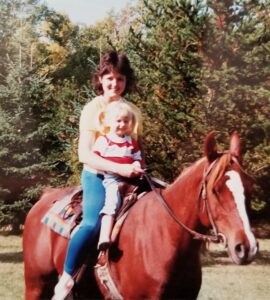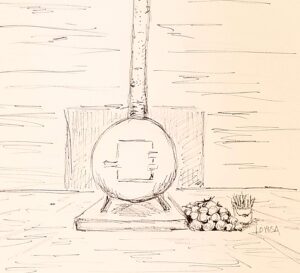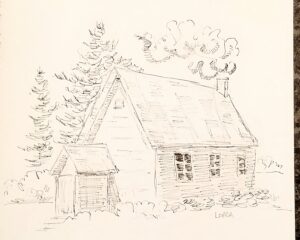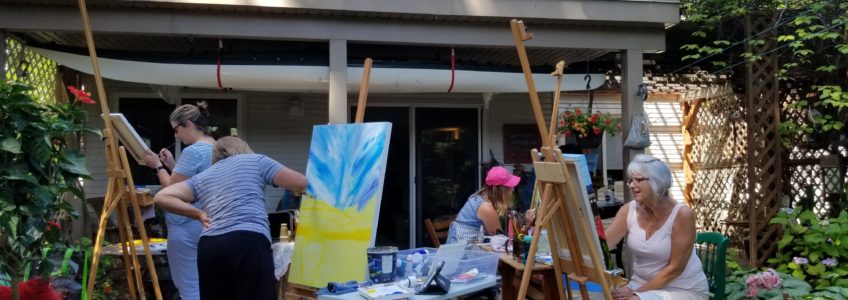This is a very good question. Becoming an art teacher is something very special. You are imparting your knowledge to students of all ages. Whether you are teaching an on-going class or a weekend workshop, you are an influence on that person’s growth as an artist.
How you get there is always an interesting story. It is different for everyone. Some choose university to pursue a fine arts degree and others just get chosen because of the things they do. Volunteering at schools, summer camps, museum art programs, Girl Guides and Scouts’ groups; the list goes on. The latter is how I got started.
The late Pierrette Dulude Bohay was my mentor in my early 20s, she told me, “Share what you know. If you don’t know, find out, try it and share your results.” Those words put me on track to becoming a teacher. That has stuck with me throughout my career as an artist, mentor, and as a teacher.
How I Became An Art Teacher
My very first teaching experience happened in an unexpected way. I had moved from Ottawa to the small community of Devlin in Northwestern Ontario. I was at the country store picking up a few items. The clerk introduced herself and welcomed me to the community. Like most small towns, when you have a new arrival, you ask all kinds of questions so that you can inform the next person who shops a bit of information on the newcomers. Our family was the new topic of the week. “What do you do?”, asked the clerk. I am a stay-at-home mom and an artist. “Really?!” she replied with excitement! “Could you teach a group of us to paint?” I was caught off guard. I had never been asked to teach before. I responded with, “My house is very small. I wouldn’t have room.” “Not to worry; we have an old school house we can use for the classes. It is not far from where you live”, she informed me. I thought to myself, ‘She knows where I live!’ She asked for my phone number so she could contact me when she had students interested in classes in the fall. I went on my merry way excited and nervous about what just happened. All kinds of questions went through my head, I’ve not gone to school to teach. Can I do this? Is this really happening? What do I charge? Where do I start? I wrote down a whole list of questions and answered them. Where do I start? Answer: at the beginning, of course. What if they ask me a question and I don’t know? Answer: I’ll find out and demonstrate it next week. By the time I got through my list of questions I thought, ‘Yes, I can do this!’
The summer rolled into fall and I got the call; a double-ring on the landline. For those of you too young to know what that means, in small communities you usually had what was called a ‘party line’. It’s not what you’re thinking! You answered the phone on your ring, ours was two quick rings. If you picked up on someone else’s ring you could hear their conversation and it wasn’t unusual to pick up the phone to make a call and there was already a conversation going on between others. You said, “Oh, sorry” hung up and you waited for a few minutes and tried again.
“Linda, we would like to hire you to teach us to paint in oils starting in October. Once a week at 7pm till 9pm. There are 8 of us. Is it okay if one of us is only 10 years old? Can you meet me at the schoolhouse at 5pm on Saturday and I can show you what you need to do and give you a key?”
“Yes, I’ll be there,” I replied.
Wow, this is really happening! Out came the books (there was no internet back then), to refresh my memory of composition, perspective, mixing colours, and so on. All that week I painted with a different outlook; analyzing and dissecting every movement of my brush. The way I pick up colour off my palette. Asking myself questions they might ask. What is the answer? How do I explain it? Where do I stand when I demonstrate? Do I demonstrate? All very valid questions.
Saturday arrived and I decided to ride my horse Geronimo to the school house. It was a pleasant fall evening; the ride was a good way for me to reflect on what I was about to commit to. When I arrived, the organizer was surprised to see my mode of transportation and smiled.

She opened the school house door which opened up into one big room with a giant barrel wood stove at one end. She gave me the tour and showed me where the light switches were; then she proceeded to tell me that I had to come 2 hours before every class. This was to get the fire going in the stove so that the school would be warm enough. You might think that I am either really old or that I’m making it up but I kid you not. I arrived two hours early, got the old stove going, went home, cooked dinner for my family, and then went to teach my very first oil painting class.

My first class at the schoolhouse brought tears to my eyes afterwards. I was so excited; they enjoyed it and learned a lot. I could actually teach! The painters in my class ranged from 10 to 85. I will always cherish that first experience teaching. Everyone worked on their own subject matter. There was a tiger, several landscapes, a seascape, and people! Oh my gosh, people! I spent a lot of time learning between classes. Learning and sharing. I grew as a teacher and the students grew along with me.

I still learn and then share what I’ve learned. In 1999 I got a call from the Royal Conservatory of Music. I had been recommended by the director of the Rainy River Board of Education as a possible candidate for the “Learning Through the Arts “program. I received a call for an interview, I said “I’m sorry you must have the wrong number. I didn’t apply for a job with the Royal Conservatory.” She responded with, “You came highly recommended, please meet with us so we can tell you what is involved.” I couldn’t believe this was happening. I had volunteered in the schools for a number of years. I had been noticed for my abilities to work with the teachers and the children. Two weeks later I was on my way to Toronto for training. This gave me additional insights into integrating the arts into the school curriculum. My education with the Learning Through the Arts program is so valuable even today. What an amazing experience – and it continues to open many doors for me.
Advice For Becoming an Art Teacher
To become a great teacher, you need to learn to share, to simplify your instruction and, just as important, to use lots of patience when teaching. As a painting teacher you are teaching more than just art. You are teaching your students to see our beautiful world with new eyes. Sometimes you are unaware of how teaching painting might also be affecting your students in other areas of their lives. It can have unexpected social or psychological benefits for your students. If you are passionate about what you do then perhaps you are a teacher too. You just have to give it a try to find out.
Good luck!
Linda Lovisa
‘Use More Paint!’

